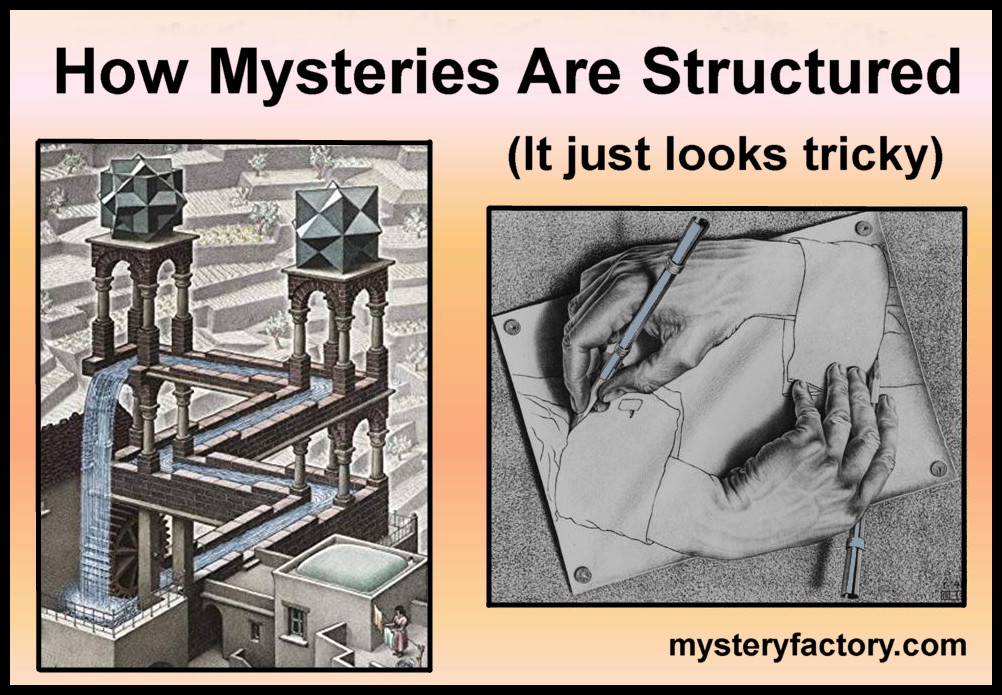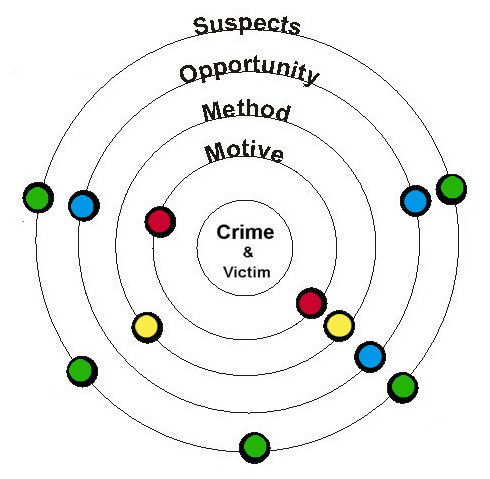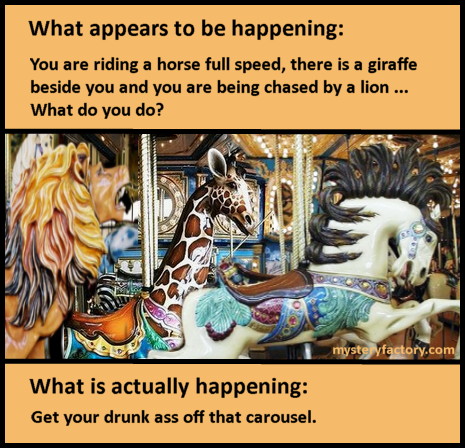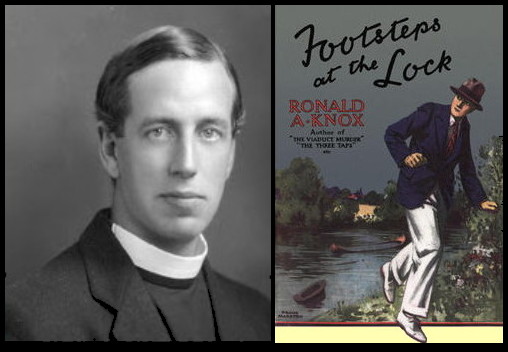WRITE Mystery PLOTS for Scripts or Stories
Writing mystery plots can seem complicated but it becomes simple when you break the structure down to a ‘step by step’ process.

For over 30 years I have had to come up with mystery plots, complete with clues, on short notice. During that time, I created a series of diagrams to help me do this. The MYSTERY BONES diagrams help me keep track of the character details, make sure there are no loose ends, and provide me with a way to make sure all the clues and red herrings are in place.
Along the way, I read and analyzed all the Agatha Christie novels, a lot of Rex Stout, and many other fair play mysteries. I drew diagrams like crazy, with plenty of arrows and equal signs, doodles and underscores, before a system started to show itself. My aim was always to simplify the process, to make things clear.
Overview of the
MYSTERY STRUCTURE
A MYSTERY STRUCTURE can be divided into Seven Parts
1. What happens?
THE CRIME
2.Who is involved?
THE CHARACTERS
3. Why did it happen?
THE MOTIVE
4. How did it happen?
THE METHOD or MEANS
5. When did it happen?
THE OPPORTUNITY
6. Where did it happen?
THE CRIME SCENE
7. What is the solution?
THE CLUES
Where do I start?
You can start at any one of the seven parts.
PICK ONE

Any one of them can be an entry point for your writing. Any of them can be the inspiration that gets you started … and excited. If you are excited about what you are writing, then your readers will feel that excitement when they read or watch your mystery.
Many considerations will come up as you write. If you try and tackle them all at once, you can easily become overwhelmed and confused.
Taking the process STEP by STEP will keep you clear and on track. There are plenty of decisions you (and your characters) will make along the way, which turns your mystery unique -like you!
There is no particular order in which to begin your mystery because writing the plot is not a linear process. The setting, the characters and their motives and the crime itself are all intricately tied together. If you are writing a script for live entertainment, then the parametres you follow are going to be narrower than if you are writing a story for a book or film.
Do you have an idea about …
What happens – an overview of a captivating situation?
Who is involved – any particular type of nefarious or super character?
Why something happened – a motive that gets your blood boiling?
How it happened – intrigued by a challenging murder method?
When – passionate about time travel or a certain time of day?
Where – curious about historic, futuristic or exotic locations?
The Clues – in love with strategy and puzzles?
Some Things to Keep in Mind
MYSTERIES are CIRCULAR by NATURE

Mysterys are circular by nature. Their construction is circles within circles. Because of the shape of a mystery there are many different points of entry when devising a cluetrail.
In the centre of the circle is the crime. Around the circumference are the suspects. Orbiting between the centre and the circumference are the motive, method, opportunity.
Mysteries are incredibly flexible. They can bend and twist to fit any circumstances or situation. If you are writing an interactive mystery event, you just have to know what you have to work with in the beginning to save yourself the work of adjusting elements later on.
If you are writing a book, you have much more freedom – but you still need to know where you are going to end up. One of the great joys of being a writer is being able to lay the infrastructure so that it supports all the twists and turns you are going to pull your reader through on their way to solving the crime.
This does not mean you are married to a rigid outline or structure. Yes, you do have to make one, but if along the way a better idea pops up, follow it as far as you reasonable can. If this bright new idea is asking you to rearrange just about everything – it’s probably a different book. If you can easily tweak existing ideas to support the new twist – by all means follow it if it improves the story.
MYSTERIES are really TWO STORIES
What happened and what appeared to happen

One story is What Appeared to Happen, and the second story, which everyone is trying to figure out, is What Really Happened.
What Happened is the story. What Appeared to Happen makes it a mystery.
ADVISE From The EXPERTS
P.D. James
“With Agatha Christie ingenuity of plot was paramount – no one looked for subtlety of characterization, motivation, good writing. It was rather like a literary card trick. Today we’ve moved closer to the mainstream novel, but nevertheless we need plot.”
Mickey Spillane
“Nobody reads a mystery to get to the middle. They read it to get to the end. If it’s a letdown, they won’t buy anymore. The first page sells that book. The last page sells your next book.”
Anton Chekhov
“If somebody places a gun on the mantle in the first act, it must be fired before the end of the second.”
Alfred Hitchcock
“There is no terror in the bang, only in the anticipation of it.”
Benjamin Franklin
“Three may keep a secret if two of them are dead.”
Joseph Hansen
“Don’t just say it’s raining – make us feel the sodden weight of a wall of water driven by winds at sixty miles an hour.”
The TEN COMMANDMENTS of PLOT DEVICES from 1928

In1928, Father Ronald Arbuthnott Knox (1888 – 1957) priest and crime writer, created a “Ten Commandments” of plot devices that more or less codified the rules of the Fair-play whodunnit. A few of them are vastly outdated now, but still, fun to look over and appreciate in principal:
- The criminal must be someone mentioned in the early on, but must not be anyone whose thoughts the reader has been allowed to follow.
- All supernatural solutions are ruled out.
- No more than one secret room or passage is allowable, and must be appropriate.
- No hitherto undiscovered poisons may be used, nor any appliance which will need a long scientific explanation at the end.
- No Chinaman must figure in the story. ( A case of unsophisticated anti-racism, given the Yellow Peril figures prevalent in dodgy crime fiction at the time.)
- No accidents or lucky intuition must ever help the detective.
- The detective must not himself commit the crime.
- The detective must not light on any clues which are not instantly produced for the inspection of the reader.
- The detective and his sidekick must not conceal any thoughts which pass through his mind.
- Twin brothers, and doubles generally, must not appear unless we have been prepared for them.
HOW TO WRITE MYSTERIES
The Book CLUE TRAIL
THE CRIME
THE CHARACTERS
MOTIVE, METHOD, OPPORTUNITY
THE CRIME SCENE
CLUES & EVIDENCE
CONSULTATIONS
HOME
I am trying to write a mystery book but it is difficult what are some tips and by the way its not a murder its a theft. Thanks.
Hello Mystery Lover!
A mystery has two components; ‘what actually happened’ and ‘what appeared to have happened’. You tell the story of ‘what appeared to have happened’ and your detective or protagonist figures out ‘what actually happened’. This is often accomplished by telling the story out of chronological sequence. Know what actually happened before you start, break it down into pieces and then toss them out there for your sleuth to find and put back together.
A mystery doesn’t have to be a murder, in fact it doesn’t even have to be a crime. A ‘whodunnit’ simply means that an unknown person performed an action – no matter if the action is a murder, a theft, or the baking of a cake. Basically you want to have your theft have the motive, the method and the opportunity (The Mystery Bones) to have committed the theft and then create the clues to prove that he had, indeed, each of those three things. You will also need to create clues to show that other people also had one or two of the Bones (motive, method or opportunity) otherwise there is nothing to solve. You can get a bit of help with the clues here.
Put the crime, or a piece of intrigue leading up to the crime, at the beginning of the story. You want to grab the reader and have them asking questions right away. Keep the action going right up until the end. ‘Give hope. Take hope away. Give hope. Take hope away.’ Let your detective make wrong assumptions and then figure out what a clue really means at the last minute. If you enjoy writing your mystery then others will enjoy reading it.